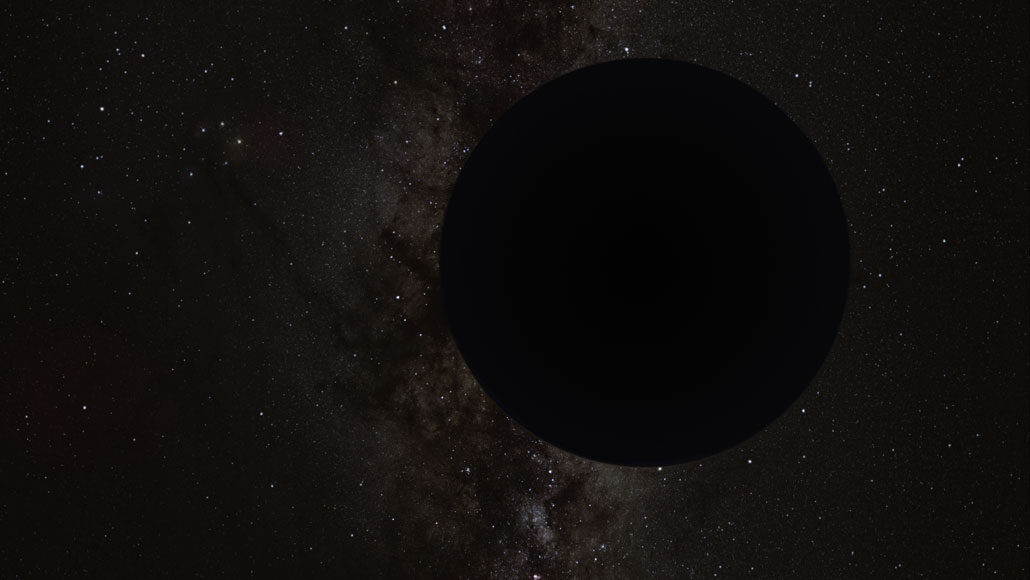Signs of a hidden Planet Nine in our solar system may be an illusion
A remote planet isn’t ruled out, but evidence for one may be fading

Planet Nine (illustrated) is a hypothetical giant planet hiding at the solar system’s edge. However, new work suggests the evidence for it is a mirage.
ESA/Hubble, M. Kornmesser
Planet Nine might be a mirage. What once looked like evidence for a massive planet hiding at the solar system’s edge may be an illusion. That’s the conclusion of a new study.
“We can’t rule it out,” says Kevin Napier of Planet Nine. He’s a physicist at the University of Michigan in Ann Arbor. “But there’s not necessarily a reason to rule it in.”
Previous work had suggested that a number of far-out objects in the solar system clump in the sky as if shepherded by an unseen giant planet. That planet would have to have at least 10 times the mass of Earth. Astronomers dubbed the invisible world Planet Nine or Planet X.
Now, a new analysis of 14 of those remote bodies shows no evidence for such clumping. The study knocks down the primary reason to believe in Planet Nine. Napier and his colleagues shared their findings February 10 at arXiv.org. The paper will appear later in the Planetary Science Journal.
Chad Trujillo is an astronomer at Northern Arizona University in Flagstaff. Scott Sheppard is an astronomer at the Carnegie Institution for Science in Washington, D.C. In 2014, they revived interest in the idea of a distant planet lurking far beyond Neptune. At the time, they reported a collection of distant bodies with strangely bunched-up orbits near the edge of our solar system. Those distant bodies are called trans-Neptunian objects.
In 2016, planetary scientists Mike Brown and Konstantin Batygin reported new findings. They work at Caltech in Pasadena, Calif. This pair used six trans-Neptunian objects to refine the possible properties of Planet Nine. They pinned it to an orbit between 500 and 600 times as far from the sun as Earth’s is.
But those earlier studies all relied on just a handful of objects. Those objects may not have represented all that’s out there, says Gary Bernstein. He’s an astronomer at the University of Pennsylvania in Philadelphia who works with Napier. The objects might have seemed to show up in certain parts of the sky only because that’s where astronomers were looking.
“It’s important to know what you couldn’t see, in addition to what you did see,” he says.

Educators and Parents, Sign Up for The Cheat Sheet
Weekly updates to help you use Science News Explores in the learning environment
Thank you for signing up!
There was a problem signing you up.
Illuminating hidden objects
To account for that uncertainty, Napier, Bernstein and their colleagues used observations from three surveys. They used the original one run by Sheppard and Trujillo. To this they added the Dark Energy Survey and the Outer Solar System Origins Survey. In all, it gave them 14 trans-Neptunian objects to study. That’s more than twice as many as in the 2016 study. All of them are between 233 and 1,560 times as far from the sun as is Earth.
The team then ran computer simulations of about 10 billion fake trans-Neptunian objects. These were distributed randomly around the sky. That let the researchers check to see if the positions of the 14 known objects matched what the surveys should be able to see. And they did.
“It really looks like we just find things where we look,” Napier says. Think about what would happen if you lost your keys at night. You might search for them under a street lamp — not because you thought they were there, but because that’s where the light was. The new study basically points out the street lamps.
“Once you see where the lampposts really are, it becomes more clear that there is some serious selection bias going on with the discovery of these objects,” Napier says. That means the objects are just as likely to be distributed randomly across the sky as they are to be clumped.
But that does not mean Planet Nine is done for, he adds.
“On Twitter, people have been very into saying that this kills Planet Nine,” Napier says. “I want to be very careful to mention that this does not kill Planet Nine. But it’s not good for Planet Nine.”
Still a mystery
There are other mysteries of the solar system that Planet Nine would have neatly explained, says Samantha Lawler. She’s an astronomer in Canada who did not take part in this study. She works at the University of Regina in Saskatchewan. A distant planet could explain why some far-out solar-system objects have orbits that are tilted relative to those of the larger planets. Or, she adds, it might explain where proto-comets called centaurs come from. That was part of the appeal of the Planet Nine hypothesis.
“But the entire reason for it was the clustering of these orbits,” she adds. “If that clustering is not real, then there’s no reason to believe there is a giant planet in the distant solar system that we haven’t discovered.”
Batygin, an author of the 2016 paper, isn’t ready to give up. “I’m still quite optimistic about Planet Nine,” he says. He compares Napier’s argument to seeing a group of bears in the forest. If you see a bunch of bears to the east, you might think there was a bear cave there. “But Napier is saying the bears are all around us, because we haven’t checked everywhere,” Batygin says. “That logical jump is not one you can make.”
Evidence for Planet Nine should show up only in the orbits of objects that are stable over billions of years, he adds. But unstable objects have “strongly contaminated” the new study, he says. These bodies may have been nudged by Neptune and lost their position in the cluster. They also may be on their way to leaving the solar system entirely.
Lawler says there’s not strong agreement yet among people who study trans-Neptunian objects about which ones are stable and which are not.
Everyone does agrees, though, that astronomers need to find more trans-Neptunian objects if they hope to prove whether Planet Nine’s exists. The Vera Rubin Observatory in Chile should find hundreds more once it begins surveying the sky in 2023. “There always may be some gap in our understanding,” Napier says. “That’s why we keep looking.”







